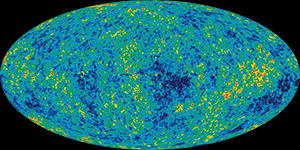
The cosmic microwave background (CMB) originated just 380,000 years after the Big Bang, when the Universe was dense, hot, and opaque. As the Universe cooled, the light was decoupled and escape from the matter. We observe that same light today, stretched by the expansion of the universe to a cold 2.7K glow. Observations of the CMB have driven our understanding of the early Universe, and are one of the few probes of the inflationary epoch. Inflation describes the brief period of extraordinary expansion where the Universe went from the atomic scale to visible scales, and where small density fluctuations ultimately led to the large-scale structure — galaxies and clusters of galaxies—that we observe today. Maps of the CMB provide a precise measurement of the geometry of the Universe, and show that it is "flat," governed by Euclidean geometry on cosmic scales. The detailed spatial and statistical properties of CMB maps are consistent with the predictions of inflation. However, the physical process behind inflation remains unknown. New measurements of the polarization properties of the CMB will help uncover this process, which lies at energies and densities beyond standard particle physics, and beyond terrestrial particle accelerators. By searching for a characteristic polarization signal from a background of gravitational waves produced by inflation, we can infer the energy scale of inflation, which may lie at the scale of grand unification of the forces of nature.